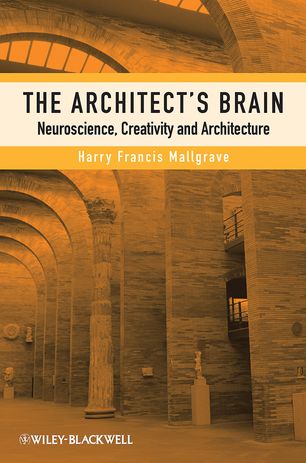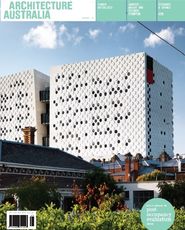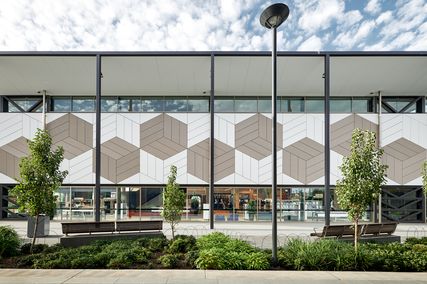
The Architect’s Brain: Neuroscience, Creativity and Architecture by Harry Francis Mallgrave.
The first thing I did with this book was flick through its illustrations. Being an academic text, there aren’t many, but one caught my attention: Sébastien Le Clerc’s 1674 engraving of the Louvre under construction. In it, the foreground is littered with people and building supplies. Behind this, to the left, a clean and perfect Louvre emerges from some monumental scaffolding. Apart from some diagrams of the cranial brain, the rest of the illustrations are of finished Renaissance and post-Renaissance classical buildings – Monuments R Us. There’s not a single plan.
The illustrations accurately herald the text, which comes in two parts. The first part, called History Essays, is a chronology of architectural theory; that is, a chronology of books. The earlier books are all architectural. At the eighteenth century, philosophy joins in, then art history, then science. The chapters discuss successive “Brains”: the Humanist, the Enlightened, the Sensational, then (skipping a few) the Gestalt, Neurological and Phenomenal “Brains.” The second part of the book attempts to link the latest in neuroscience with current architectural paradigms. Here, the brain’s anatomy is described, and ambiguity, metaphor and hapticity are discussed as conditions of the new neuroplastic brain. There is an epilogue called “The Architect’s Brain” that seems to promise an executive summary – more on this chapter later.
Despite the book’s title, the body is the driving metaphor. Exemplified by Alberti, Vitruvius and Leonardo, the Humanist Brain imagined architecture through a body image, with Leonardo’s famous circle/square diagram providing its corporate logo. This architectural body then appears to have transformed over the centuries to become the modern Phenomenal Brain, which is not just the grey lump protected by a bony skull, but something with channels out to the eyes, tongue, ears, fingertips, feet and genitalia. Remember that drawing of the body with its most sensitive bits enlarged to their relative perceptual importance? That’s not the body, that’s the brain. Or rather, in a deft move to cancel the mind/body problem, Mallgrave says it’s the body and the brain.
The latest neuro news is that the body/brain is not a fixed entity. Only notionally connected together at birth when it is more of a potential network than a fixed given, the brain is wired up by us as we live, but only in so far as it lets us. The brain comes with (develops?) tendencies and schema; these limit what we can take in and process. How these limits come to be is a matter of how we are brought up and educated; that is, brainwashed. That other annoying dualism, nature/nurture, is ignored. Maybe it needs another book, as neuroscience stops at the outside edge of individual brains. Hence Mallgrave’s History Essays are limited to successive architectural styles or fashions tied to specific people. But there are more problems with this than nature/nurture. Mallgrave is an accomplished historian, and must be familiar with the reality of many different styles or “Brains” existing at the same time, with untidy ways of jumping time and place all over time and all over the place. Take the case of Andrea Palladio. Initially his “Brain” was Venetian. Mallgrave mentions him in The Humanist Brain, in passing in The Enlightened Brain, and has him firmly wedged in the discussion of modern neuroplasticities through ambiguity and metaphor. But the Palladian Brain is also diasporic, occupying the Baltic, jumping to England and across the Atlantic to America, and then crossing the Pacific to Australia via the military and the first free settlers. This discontinuous movement took place while central Europe cooked up a number of other paradigms. Palladianism is thus a mixed social history, even in its Venetian version.
So the word “brain” is used in this book in two distinct ways. The first way refers to the organ inside the skull. This is the territory of neurones, synapses and substructures of reptilian and instinctive control centres. In the second usage of the word, brain is a sign of knowledge; a sign of thinking in a particular way. This is the abstract, non-territorial existence of ideas and theories.
Mallgrave’s mission appears to be to connect these two and this, I think, is why the history half of the book has to be couched in individual terms. No hard principles emerge from the attempted integration, possibly because both ideas and cranial matter are elusive, shape-shifting chimeras. But this confrontation allows Mallgrave to present a high-speed trip through architectural theory, and to muse happily on current architecture. At this level, the book is a great read, constantly shifting its story and picking up lots of entertaining detail. On the other hand, the raciness could be because the material is a kind of précis to Mallgrave’s much larger book, Modern Architectural Theory: A Historical Survey, 1673–1968.
If you are a practitioner, beware: this book is not about architectural practice, or architecture as a process. For Mallgrave, architecture consists of evident, completed works, of objects well past initiation, design and construction. Yet practitioners know how government elections, contractual systems, construction, information systems, media and so on are affected by the architect’s brain and how they affect that brain in turn. And it’s in that environment that architecture is created, that architects use their brains, in all senses of that word. That’s the “Brain” that is given an image in the etching of the Louvre that took my attention. Can anything specific be said of an “architect’s brain”? If neuroscience is any guide, the answer is no. Any architect’s cranial brain is the same as any other person’s. But the concept-driven “Architect’s Brain” may be different or special. Or might not be, if you believe in the Zeitgeist, where everyone shares or makes up the “spirit of the times.” In any case, Mallgrave avoids this issue in his epilogue and instead indulges in a diatribe against the computer in design education. Probably because conventional discussion treats the computer as an artificial brain, Mallgrave must at least acknowledge its pervasive existence, but then he provides his own “beware!” He blames the computer for the superficial, un-tectonic, conformist products of the young. Mallgrave is about my age, and must have been looking elsewhere when in previous decades many superficial, un-tectonic and conformist buildings were designed using pencils and Rapidographs. He must also be blind to the fascinating work coming out of digital research at both student and professional levels. His outburst against the digital world gives his excursion a sour ending. My recommendation is to read the book and ignore the epilogue.
Harry Francis Mallgrave, Wiley-Blackwell, 2010, 288 pp, RRP $150.
Source

Discussion
Published online: 18 Jan 2012
Words:
Alex Selenitsch
Issue
Architecture Australia, September 2011














